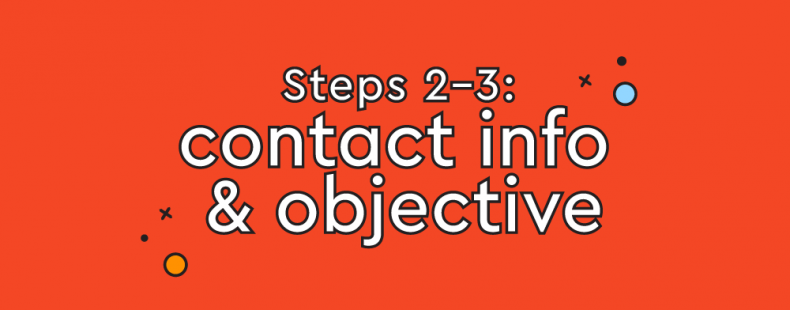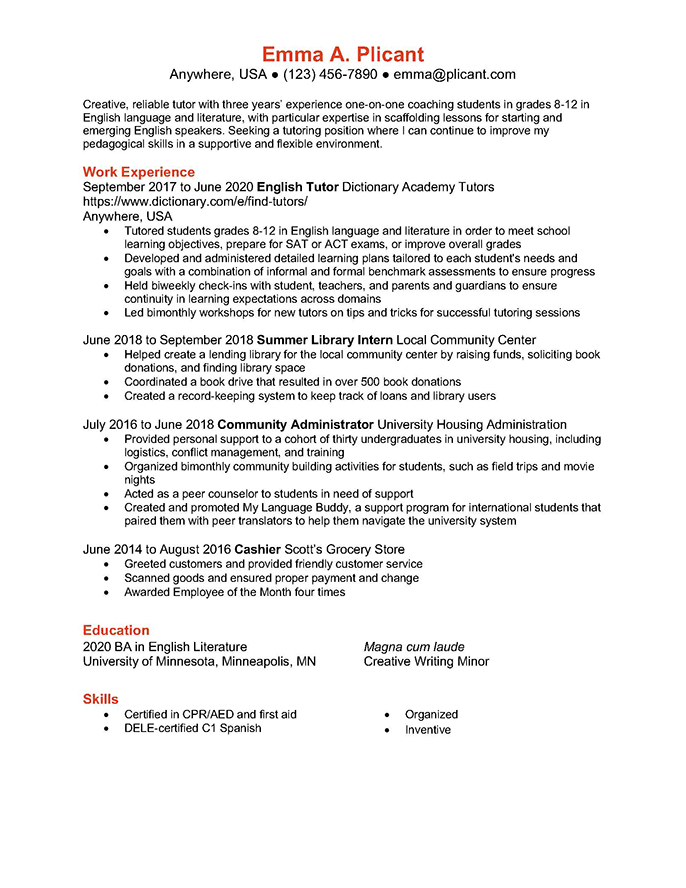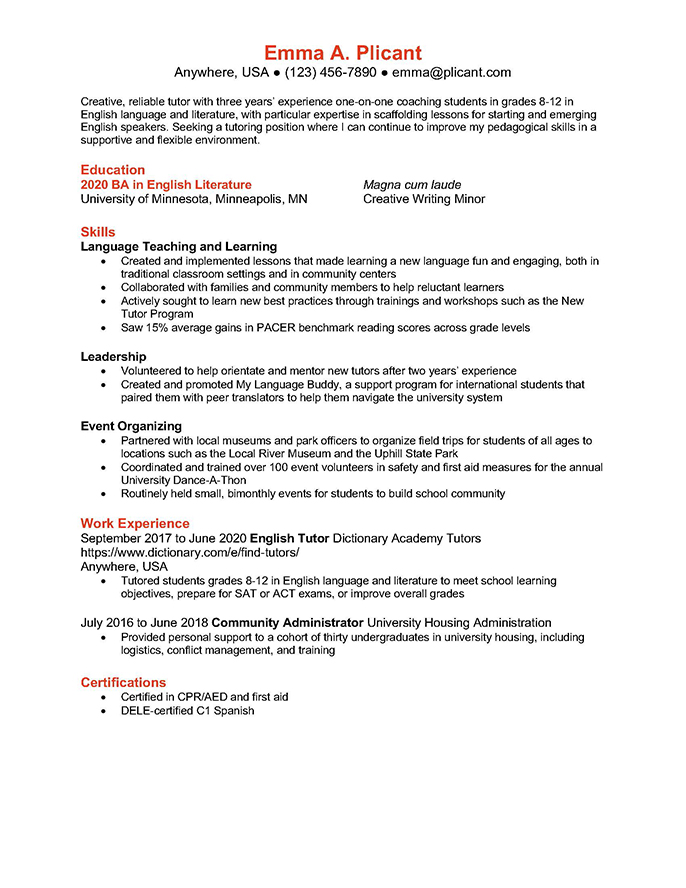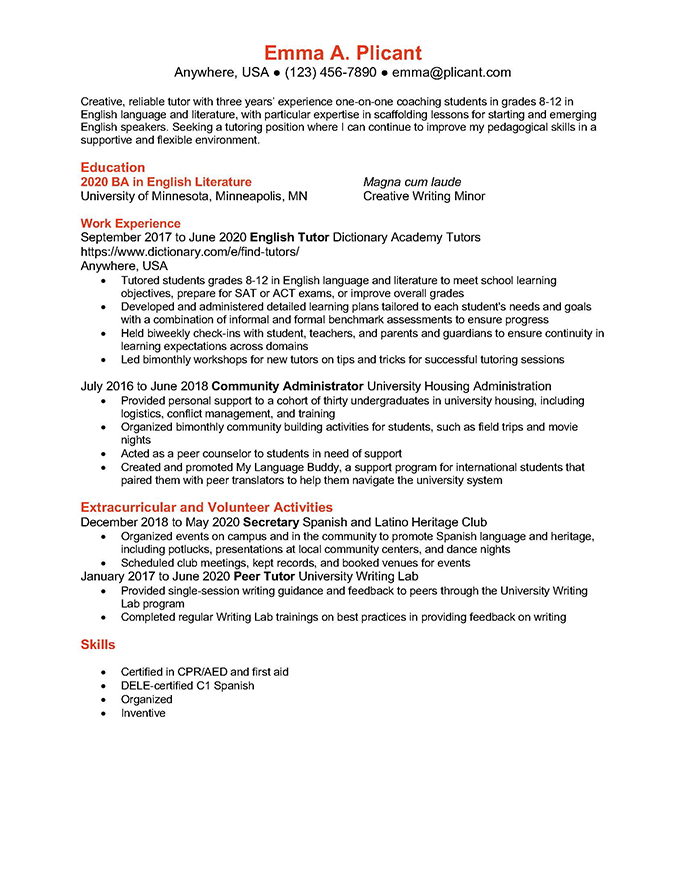You’ve found the perfect job. Are you ready to write the perfect objective for your resume?
Your objective will make the case for why you’re the right candidate for the opportunity. But we’re getting ahead of ourselves.
This article covers steps 2 and 3 (out of 10 steps) of how to write a strong resume. Every resume is slightly different depending on the field and personal experience, but there are some general guidelines that everyone should keep in mind when writing a resume. This article provides an overview of the contact information you should include in your resume and how to craft an objective.
Step 1. Choose a Resume Format
✅ Step 2. Include Appropriate Contact Information
✅ Step 3. Write a Stellar Objective
Step 4. Highlight Relevant Experience
Step 5. Add Relevant Skills to Your Resume
Step 6. Include an Education Section
Step 7. List Certifications and Awards
Step 8. Incorporate Action Verbs, Adjectives, and Other Buzzwords
Step 9. Edit Your Resume
Step 10. Share Your Resume
We’ve provided three sample resumes you can use to follow along in this series and create your own format. There are three templates linked here (click on the images below to expand them), but each format is explained in more detail in step 1 of this series.
- the chronological resume
- the functional resume
- the combination resume
Step 2. Include appropriate contact information
The first thing to do when writing your resume is usually easy: providing how you can be reached.
Must-have contact information
Your contact information should definitely include:
- Name
- Phone number
- Email address
Name
You don’t have to write your full legal name on your resume—it is up to you if you want to go by your everyday name (e.g., Chris for Christopher) or if you want to drop your middle name. Remember, though, that it is one of the very first impressions an employer has of you. You probably don’t want to go by a nickname (T-bird), as that can come across as unprofessional.
Email address
Similarly, your email address should reflect your level of professionalism. An email address is free to create, and it only takes a few minutes. If you’re still using your grade school email address of butterflyluver892@email.com or numbaoneswifty@email.com, it’s time to upgrade. Ideally, your email address should be some form of your name or initials, with numbers if needed, such as emma.ply15@email.com. If you’re a freelancer or just serious about branding, you may also choose to create an email domain that reflects your name or brand, such as emma@plytutor.com
Optional contact information
Your contact information may include:
- Location or full mailing address
- Current job title or professional title
- Personal website or online portfolio link
- LinkedIn profile link
Address
Today, a full mailing address on a resume is much more optional than it used to be. Some even warn against it due to the possibility of identity theft. It is generally sufficient to simply provide the name of the city and state where you live. It’s often more relevant when applying to local jobs, rather than remote work.
LinkedIn, personal website, & portfolios
If you have a professional online presence, such as a personal website or LinkedIn, you may choose to link to it on your resume. This can be a great addition, especially for creative jobs that require a portfolio. However, be aware—employers will check out those links, and you will want to make sure all of the information on the linked sites is accurate and up-to-date before applying.
Step 3. Write a stellar objective
A strong objective or resume summary is a good way to make your resume stand out from the rest. An objective statement needs to accomplish two things: 1) articulate your career goal, and 2) describe how you would be an asset to the employer. In other words, why do you want this job, and why would you be good at it?
Before we get into some examples, here are some general guidelines for how to write a stellar objective:
- 1–3 sentences in length
- Features keywords from the job posting or description
- Summarizes career goals
- Describes what you could contribute to the workplace
- Specific: use concrete, not general language
- Genuine: be honest about your interests and accomplishments
Hiring managers may pass over a resume if they feel the objective isn’t tailored enough to the position or if it uses too many generalities or buzzwords.
Not every resume will require a resume objective or summary. In fact, some people counsel against them unless you are making a drastic career change or returning to the workforce after a long absence. If you are having trouble fitting all of your work experience and other information onto a one-page resume, you can consider cutting the objective for space.
Let’s take a look at a couple of examples.
Resume objective examples
Take a look at this resume objective statement a recent college graduate wrote for a position as an English tutor at a local company. Do you think it is a strong objective? Why or why not?
- Hardworking English major with a passion for education seeking a position where I can help others learn. Reliable, patient, and helpful. Good with kids.
This statement does some things well. For example, it describes both the applicant’s career goals and what qualities she might bring to the workplace. But, its language is informal and general. This statement would be stronger if it used more specific and descriptive language:
- Creative, reliable tutor with three years’ experience one-on-one coaching students in grades 8–12 in English language and literature, with particular expertise in scaffolding lessons for starting and emerging English speakers. Seeking a tutoring position where I can continue to improve my pedagogical skills in a supportive and flexible environment.
Here, we get a much clearer picture of the applicant. Language like pedagogical and scaffolding makes it evident that they have knowledge of the field. Additionally, the applicant describes their background in much more concrete terms—we learn they have “three years of experience” working “one-on-one” with “students in grades 8–12.” This objective also gives the reader a stronger sense of what the applicant is looking for: “a tutoring position … in a supportive and flexible environment.”
As you can see, it’s important to have a good understanding of both your own experience and what the job is looking for in order to write a strong resume objective. One way to do this is to carefully read the job posting, explore the workplace website, and do research on similar positions at other companies to get a holistic sense of what keywords to use and aspects to focus on. This kind of research will also be helpful for the next step of writing a resume: highlighting relevant job experience.
Go to the next step and learn how best to include relevant experience and skills in your resume.















